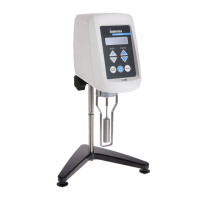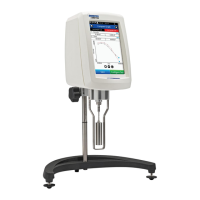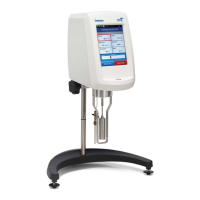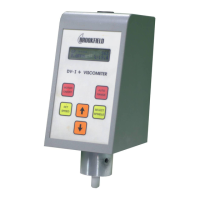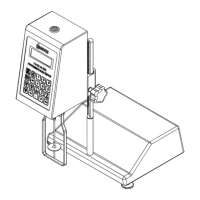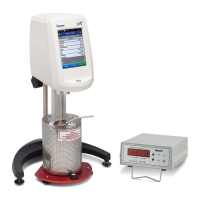Brookeld Engineering Laboratories, Inc. Page 28 Manual No. M14-023
3. Attach the guard leg (LV and RV series). Attach the spindle to the lower sha. Li the
sha slightly, holding it rmly with one hand while screwing the spindle on with the other
(NOTE: Le-handed threads). Avoid putting side thrust on the sha.
4. Enter the spindle number into the DV1 Viscometer by using the SPINDLE Hot Key. Enter
the speed of rotation by using the SPEED Hot Key.
5. Insert and center the spindle in the test material. e spindle should be inserted to the
immersion groove located on the spindle sha. Use the Laboratory Stand Clamp to adjust
the height of the Viscometer. With a disc-type spindle, it is sometimes necessary to tilt
the spindle slightly while immersing to avoid trapping air bubbles under the surface of the
disc. You may nd it more convenient to immerse the spindle in this fashion before
attaching it to the viscometer.
6. Select an end condition for the test using the RUN UNTIL function. is function is
accessed through the RUN UNTIL feature found in the Options menu. Select an end
condition (time, torque, temperature, or manual mode) and specify the parameter.
7. Select the appropriate display conguration using the TEST VIEW function. is function
is accessed through the TEST VIEW feature found in the Options menu. Select a view and
specify the format (static or variable). is feature allows the DV1 Viscometer to maximize
the display size of the key parameter.
8. To make a viscosity measurement, press the Motor On key. If using the Manual End
Condition, allow time for the indicated reading to stabilize. e time required for stabilization
will depend on the speed at which the Viscometer is running and the characteristics of the
sample uid. Additional information on making viscosity measurements is available in
Appendix C or the Brookeld publication “More Solutions to Sticky Problems”.
9. When the end condition is reached, the motor will stop and the measurement result will
be displayed. If using the Manual End Condition, the test can be stopped by pressing the
Motor O key. Record the reading and relevant test parameters. Brookeld recommends
you record at a minimum both % Torque and viscosity. Relevant test parameters might
include: viscometer model, spindle, speed, temperature, container size and time of test. A
label printer can be used with the DV1. See the sample Viscosity Test Report at the end
of the Appendices.
10. If your test procedure calls for data collected at more than one speed, change the speed of
rotation and repeat steps 8 and 9.
11. Remove the spindle and guard leg before cleaning. Remember to secure the viscometer
sha and li up slightly while removing the spindle. Clean the spindles and guard leg aer
each use. See Section I.8 for general cleaning recommendations.
12. Interpretation of results and the instrument’s use with non-Newtonian and thixotropic
materials is discussed in the publication, “More Solutions to Sticky Problems”, and in
Appendix C: Variables in Viscosity Measurements.
III.5CommunicaonwithWingatherSQSo-
e DV1 Viscometer can be used in conjunction with the Brookeld soware program Wingather
SQ. Wingather SQ will collect the data output from the DV1 and allow for: data storage, data
printing, graphing, and mathematical analysis.
NOTE: Wingather SQ must be version 4.0 or higher for use with the DV1.
e DV1 Viscometer communicates to the PC through the USB A port (See Figure I-2). e
communication cable will be supplied with the Wingather SQ soware. Communication can
be established once both the Wingather SQ soware and the DV1 Viscometer are running. Use
the Search or Connect button on the Wingather SQ dashboard (see Figure III-1). Successful
communication will be indicated by a green light beside the Port designation.

